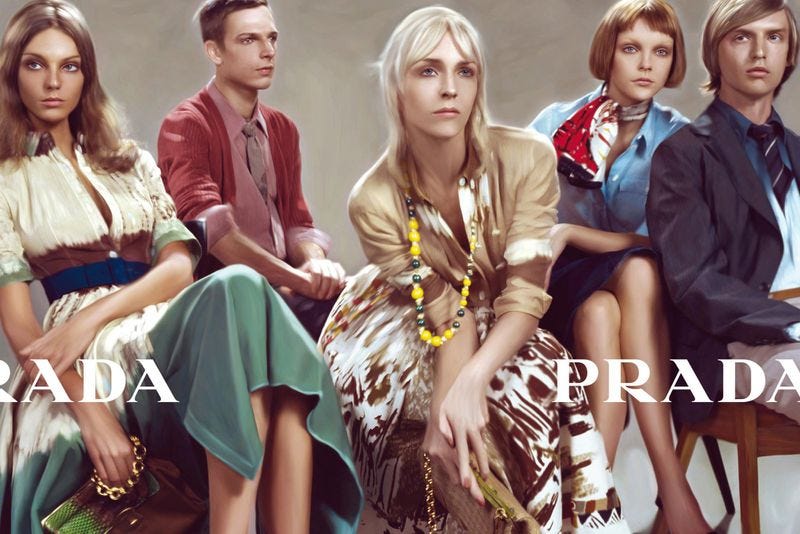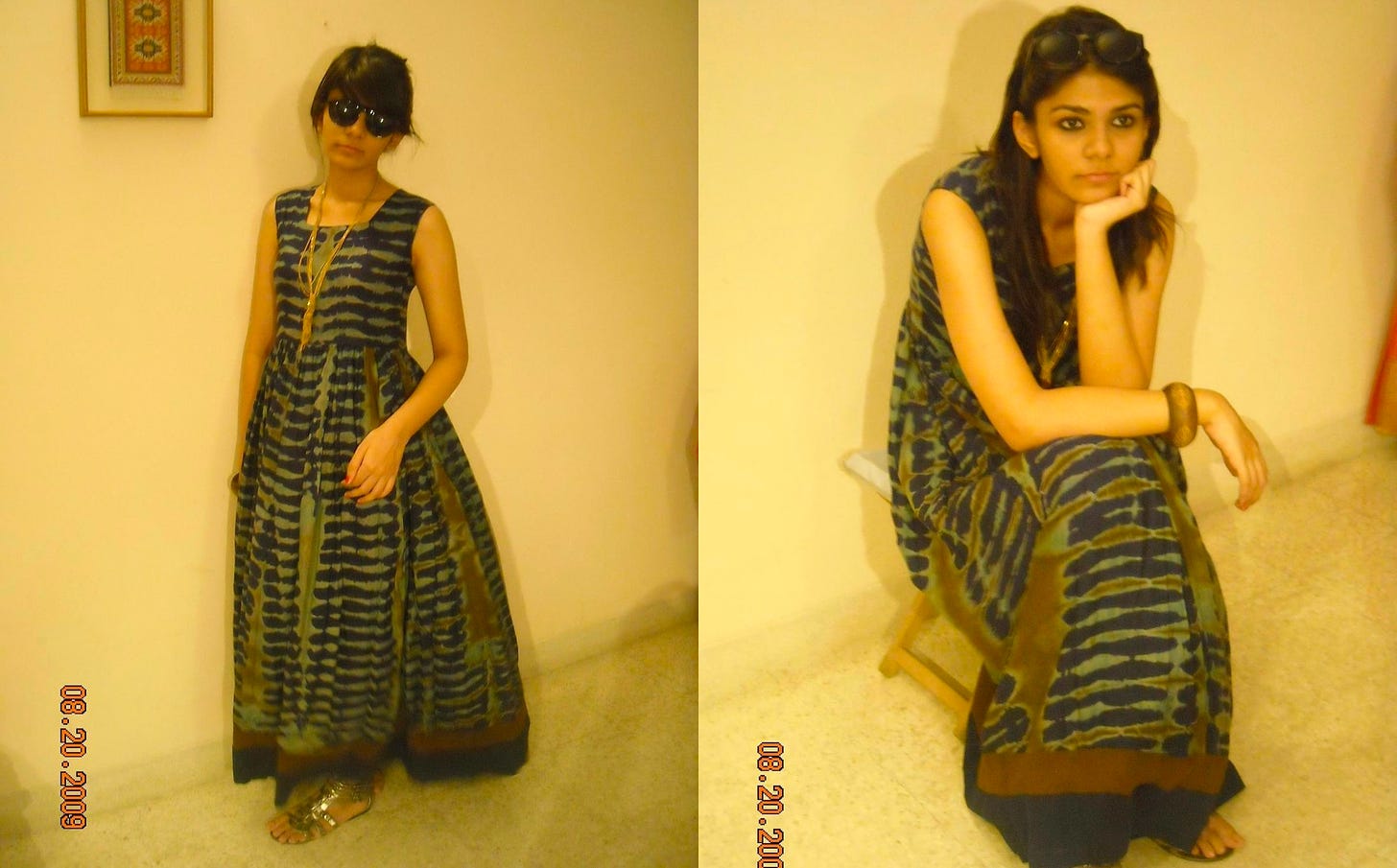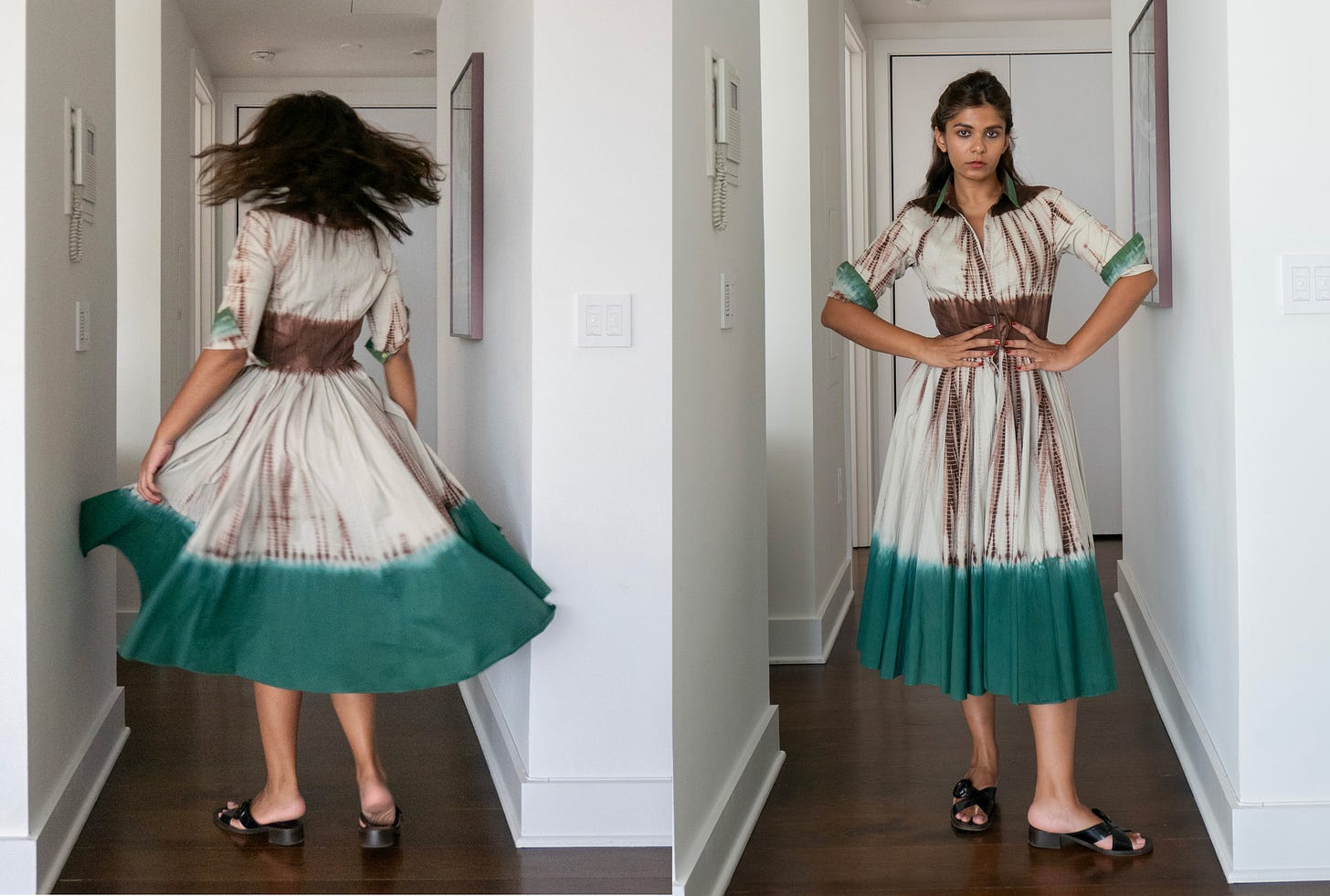Do you remember the first time? I do, I was seventeen years old. I lived halfway across the world from where I write today, the only child of strict parents, adolescent misadventures slipped right by me, and I longed for a connection I couldn’t name and hadn’t found. And then I discovered Prada.
Ever so often, I’d accompany my mother when she ran errands after work or on weekends. When it came to grocery shopping and other minutiae, I was an unwilling participant, but from my early teens I enjoyed going on trips to fabric shops and tailors’ workshops. One of the unique privileges of living in Dhaka during the early aughts was that because clothing stores were either scarce or extremely expensive, one could go to fabric shops – my personal favourites were in Chandni Chowk, a cramped and stifling market bursting with every imaginable material, beads, laces, sequins, all at our disposal to craft almost any type of garment imaginable – and select whatever was required to transform the imagined into reality, then head over to the tailor’s where clothes were made to one’s specification. Perhaps this was what launched my love affair with the rare and unusual.
On one of these errand runs, my mother, armed with fabric to be made into shirts and tunics, took me with her to visit a new tailor, someone who specialised in Western clothing and whose shop was frequented by the lot who odiously referred to themselves as “expats”, foreign employees who worked at embassies and NGOs, and who lived a pampered life they did not have to pay for and would certainly not be able to enjoy in their own home countries. But I digress! At the time, the tailors to whom we were devoted clients were skilled in traditional wear: shalwar kameezes, kurtas, the best of them could even take a hasty sketch and materials and transform them into a one-of-a-kind sari. Those trained in Western tailoring typically only did menswear, which was confirmed when one such tailor was tasked with making a pair of trousers for me, and the final product came with a generous amount of space in the crotch region.
As my mother began illustrating her vision to the tailor (Nehru collar, placket should be here not there, buttons inconspicuous!), I flipped through stacks of magazines that sat on the counter of his tiny shop; most issues were already a few years old, keepsakes discarded by his foreign clients before they moved on to the next country, or had to move back home. While perusing one magazine, I came across a campaign that seemed part photograph, part oil painting. It could have been from today or fifty years ago, not so much timeless as it was unplaceable. The models looked like waxen dolls, or maybe they were mannequins arranged to imitate life-like gestures and postures. In that image what was most striking to me was one dress in particular, a prim 1950’s style shirtdress with the sleeves pushed up, tie-dyed in shades of swamp. The model looked immaculate, verging on unreality, and utterly unbothered. It was electrifying.

“The first time I saw one of her runway shows, a few years ago,” wrote the late Ingrid Sischy in a 1999 profile on Miuccia Prada for the New Yorker, “a friend whispered, “What an incredible interior life that woman must have.” These words—surprising for a fashion show—struck home, because they seemed to pinpoint what was so riveting about what we’d seen. The clothes seemed to have something extra to them—or, rather, in them. They suggested that someone, not something, had caused them to be.” It was this “something extra”, this undefinable quality, resolutely the product of a rich interior life that I was and continue to be enthralled by.
The image of this campaign lit something within me that would take hold of my imagination for years to come. Immediately I knew, this is what I had wanted, this was what I longed for. From the moment I was allowed to dress myself, much to my mother’s chagrin, I was drawn to the antagonising. I eschewed the sensible and favoured the odd. While most of my friends and classmates were reveling in their newfound blossoming femininity, I wanted to get weird (one time a friend urged that I wear a pink top, anything remotely normatively girly in order to throw my poor crush a bone). This campaign was the embodiment of a nonlinear femininity, not informed by societal cues but rather by the rules of one’s own. It was possible to be odd and alluring. Of this distinctly Prada phenomenon, Sischy wrote, “The clothes themselves don’t necessarily have misfit connotations, and they’re not even particularly geared to young women, but, the way Prada imagines them worn, they’re like uniforms for the slightly disenfranchised.” Uniforms for the slightly disenfranchised.
How I so desired that swampy serious dress, but to possess it was inconceivable! I was but a lowly teenager, and this dress existed on the page of a fashion magazine from a world I could not even imagine. International fashion magazines were then impossible to find; when we moved from London to Dhaka in the mid 90s, among the furniture and our belongings that had to be shipped were a handful of my mother’s magazines, Harpers & Queen and Vogue, and for years I poured over them. It was the stuff of another world. But the good fortune of having spent so much time amidst stacks and rolls of materials and learning to communicate and translate my imagination to tailors – really they are the true modistes – meant that my dreams could take root.

Immediately I turned to the tailor’s shelves that held scrolls of fabric, and found what looked like the inverse of the Prada dress: dull navy cotton tie-dyed in muddy brown and quaggy green. I knew I would feel ashamed if I imitated the style entirely, but I was determined that the skirt would be full and pleated. When I received the completed dress, I felt like the richest person on earth. Seventeen years later, I still have this dress, a fond reminder of the very moment the lights had turned on and I knew exactly how I wanted to express myself through dress, and of the exceptional opportunity of being able to work with craftspeople who gave material form to my dreams amidst the bustling markets and cramped workshops.
Over the years and a move to New York later, I began searching for Prada clothing and accessories on resale and auction sites. To me, wearing Prada was a fantasy, but these platforms allowed for reveries to be realized. My first pieces included an ugly yellow tweed jacket from the Spring 1996 collection and a shift dress from Fall 2011 fit for a doll, yet, and to no avail, I carried a torch for that one dress from long ago, my introduction to the perversion of the feminine ideal. And then, something wonderful happened.
I am not the optimistically superstitious type. Tell me to manifest something, and I’ll end up with bird excrement on my head. However, two years ago, while I was in a rather compromising position (by which I mean on les toilettes, where I do my best thinking and scrolling, where the magic really happens), The Dress showed up during a routine scroll through The Real Real. Alas, right when I was about to add it to my shopping cart, a demon across the internet added it to their’s, and so for twenty minutes straight, atop my porcelain throne, I proceeded to hit refresh. I even prayed to God (one thing about me: I am very much a woman of faith when it comes to Prada), and lo and behold, it was mine.
Nearly twenty years have passed since the debut of Prada’s Spring 2004 line, which André Leon Talley dubbed “very writerly,” “very Pollyanna, with just a soupçon of the Bouvier sisters.” Was it Jackie and Lee he meant, or Little Edie? The deliberate undone innocence of the collection would suggest the latter. Still twenty years later, seventeen since my own discovery, it remains one of Prada’s more revered, beloved, and polarizing offerings, stirring within me the same joy and desire today, as a thirty-four year old woman, as it did for me as a teen.
What was going on during those Spring collections? Tom Ford, Stella McCartney, and Phoebe Philo offered straightforward and certain ideas of femininity. Alexander McQueen showed glamorous women on the verge of the Great Depression. This would have been 2003, during which time the United States, George Bush at its helm, invaded Iraq, and where, stateside, unemployment soared in the summertime. The Space Shuttle Columbia fell to pieces, and MySpace and 4Chan were born. Reality television boomed, and Fondazione Prada funded the filming of artist Francesco Vezzoli’s fake reality dating show, Comizi Di Non Amore. The beginning of the end of optimism.
Maybe Prada’s writerly Pollyannas were a response to the upward swing of violence and vulgarity of that period, an attempt at escape not afforded with ease: hemlines made to look like they’d taken a dip in mud, seams left open, postcards from across Italy! Less polished and more undone, more Little Edie, less Jackie. Whatever its true motivations, its impact on me was the opening of a portal, a new way of understanding and expressing myself and my own femininity, mine own to define and teeming with contradictions: beautiful, romantic, worldly, ugly, odd, absurd, the real wild ride of the feminine experience.




I love your self designed dress, still. And this writing.
This collection is what did it for me too!! Daria Werbowy in That Dress. I probably think about it weekly!!